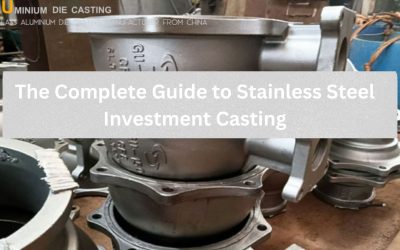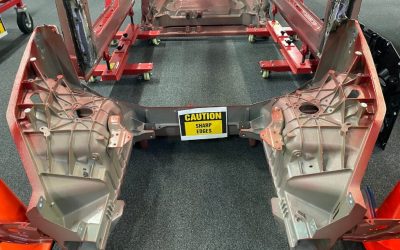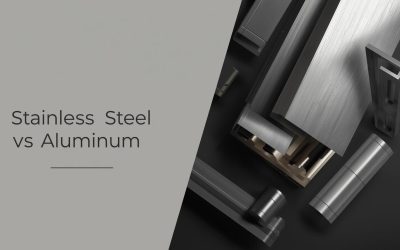Unveiling the Potential: Aluminum 6063 Die Casting in Detail
The aluminum 6063 die casting manufacturing procedure entails the high-pressure injection of molten aluminium 6063 alloy into a mould or die. Die casting frequently employs aluminium 6063 alloy due to its exceptional characteristics, which include resistance to corrosion, high thermal conductivity, a high strength-to-weight ratio, and favourable surface finish.
Among the various metal alloys, aluminium 6063 is notable for its exceptional properties and adaptability. Increasing interest is being directed towards this alloy due to its exceptional extrudability, particularly in the context of die casting. This article provides a thorough examination of aluminium 6063 die casting, including an analysis of its properties, the die casting procedure, and its applicability in a variety of contexts.
Properties of Aluminum 6063 Alloy
Of all the aluminium alloys that are out there, Aluminium 6063 is one of the most famous ones for uses that need it to be easy to extrude and look good. We will talk about the main features of Aluminium 6063 metal and how it is used in various fields below.
Composition of Chemicals of 6063 alloys
The main ingredients in aluminium 6063 alloy are aluminium, magnesium, and silicon. It is a wrought metal. The exact parts that make up Aluminium 6063 metal are these:
- Aluminum (Al): 98.9%
- Silicon (Si): 0.6%
- Magnesium (Mg): 0.35%
- Iron (Fe): 0.35%
- Copper (Cu): 0.1%
- Manganese (Mn): 0.1%
- Chromium (Cr): 0.1%
- Zinc (Zn): 0.1%
The aluminium 6063 alloy is extensively employed in a variety of sectors due to its distinctive amalgamation of mechanical and physical properties. A comprehensive understanding of these properties is critical for the effective utilisation of the alloy across a wide range of applications. The subsequent attributes pertain to aluminium 6063:
Extrudability:
- One of the most notable characteristics of aluminium 6063 is its outstanding extrudability. This feature refers to the ease with which the alloy may be shaped and produced via the extrusion process.
- Significance: Aluminium 6063’s high extrudability makes it ideal for applications requiring complicated forms and profiles. It allows for the accurate development of complex cross-sectional patterns.
Corrosion Resistance:
- Aluminium 6063 has good corrosion resistance, especially in areas where it is exposed to moisture and other climatic conditions.
- Significance: This feature makes the alloy excellent for outdoor applications and components where corrosion resistance is critical, hence increasing the material’s longevity.
Surface Finish:
- Known for generating a surface finish that is both smooth and aesthetically pleasing, the alloy is a popular choice.
- Due to the fact that a good surface polish enhances the visual attractiveness of components that are manufactured with aluminium 6063, this material is a great choice for applications in where appearance is of utmost importance.
High conductivity:
- Aluminium 6063 has a high thermal conductivity, which allows for efficient heat transfer.
- Significance: This feature is useful in applications that require heat dissipation, such as the manufacture of heat sinks for electronic devices.
Machinability:
- The alloy exhibits favourable machinability, thereby facilitating the application of various machining processes.
- Importance: Enhanced machinability facilitates the production of precise components, thereby enhancing the efficacy of the manufacturing process.
Weldability:
- Aluminium 6063 is weldable using a variety of techniques, including TIG (Tungsten Inert Gas) and MIG (Metal Inert Gas) welding.
- Significance: Weldability increases the alloy’s adaptability, allowing for the production of larger structures and assemblies using welding procedures.
Lightweight Nature:
- 6063 is inherently lightweight due to its aluminium alloy composition.
- Significance: The alloy’s low density makes it an appealing alternative in applications where weight is an important consideration, such as the automobile and aerospace sectors.
Understanding these characteristics allows engineers and producers to make more informed decisions when choosing materials for certain applications. Aluminium 6063’s unique combination of extrudability, corrosion resistance, surface finish, thermal conductivity, machinability, weldability, and lightweight properties make it a versatile and dependable choice for a wide range of applications.
 Aluminum 6063 Die Casting Process
Aluminum 6063 Die Casting Process
In the past, extrusion has been the procedure most commonly linked with aluminium 6063. Aluminium 6063, however, has defied expectations by breaking into die casting, demonstrating its adaptability and versatility. This article delves into the fascinating history of die casting with Aluminium 6063, showcasing its qualities, the method, and the many benefits it offers to manufacturers.
Die casting with aluminium 6063 alloy requires a somewhat different mould and equipment than die casting with ADC12. Here is a basic procedure for die casting 6063 alloy.
Alloy Preparation:
Melting: The process begins with the melting of aluminum 6063 alloy. The alloy is heated to a molten state in a furnace, reaching temperatures suitable for the die casting process.
Die Preparation:
- Die Design: Dies, or molds, are designed to the specific shape and dimensions of the desired component. These molds are typically made from steel and consist of two halves that come together during the casting process.
- Coating: The dies may be coated with a release agent to facilitate the removal of the casting and prolong the life of the mold.
Injection of Molten Aluminum 6063:
- Injection: The molten aluminum 6063 is injected into the die under high pressure. This pressure is maintained until the material solidifies within the mold.
- Filling the Cavity: The high fluidity and extrudability of aluminum 6063 facilitate the filling of intricate mold cavities, allowing for the production of detailed and complex shapes.
Solidification:
- Cooling: Once injected, the molten aluminum begins to cool and solidify within the die cavity.
- Ejection: After solidification, the two halves of the die are separated, and the newly formed aluminum component is ejected. The ejection process must be carefully managed to avoid damage to the casting.
Trimming and Finishing:
- Trimming: The cast component may undergo trimming or excess material removal to achieve the final shape and dimensions.
- Surface Finishing: Depending on the application, additional processes such as machining, polishing, or coating may be employed to achieve the desired surface finish.
Quality Control:
- Inspection: The cast components undergo rigorous inspection to ensure they meet the specified quality standards. This may include dimensional checks, visual inspections, and other quality control measures.
Post-Casting Treatment:
- Heat Treatment: In some cases, post-casting heat treatment may be applied to enhance the mechanical properties of the aluminum alloy.
- It’s important to note that while aluminum 6063 is suitable for die casting, there are other aluminum alloys specifically designed for optimal performance in die casting processes. The choice of alloy depends on the specific requirements of the application.
- The die casting process for aluminum 6063 combines the advantages of the alloy’s extrudability with the efficiency of die casting, resulting in the production of intricate components with desirable properties.
Suitability of Aluminum 6063 for Die Casting
Aluminium 6063 is ideal for die casting because of its high extrudability, which works well in this procedure. The alloy’s versatility stems from its simplicity of use in filling complex moulds. Die casting is an area where 6063 shines in comparison to other aluminium alloys because of its desirable properties. It finds extensive use in a variety of industries due to its lightweight nature and high machinability.
Advantages and Challenges
Another great thing about aluminium 6063 die casting is that it can make very complicated shapes very precisely and accurately and 6063 die casting parts can do anodizing surface finish. The process also lets a lot of automation happen, which makes the parts consistent and of good quality. Also, die casting can make parts with tight specs and a smooth surface finish.
One more good thing about aluminium 6063 die casting is that it is a cheap way to make a lot of parts. Die casting tools aren’t too expensive and last a long time, which makes them a good choice for large production runs. The process is also quick, which means that big tasks can be finished quickly.
Automotive parts are one of the most popular things that aluminium 6063 die casting is used for. The material is strong for its weight and easily transfers heat, so it can be used in parts of the engine, suspension, and brakes. Die casting aluminium 6063 is also often used in the electrical equipment, consumer goods, and building and construction businesses.
Work with a trusted and skilled aluminium die casting company when you need to do 6063 aluminium die casting. A good provider will know a lot about the aluminium 6063 alloy and the die casting process. They will also be able to give you high-quality parts that are exactly what you need. They should also be able to help you improve your parts for die casting by giving you technical support, such as design help.
Conclusion
Die casting out of aluminium 6063 opens up a world of possibilities for engineers and manufacturers who are looking for a material that is both dependable and versatile for the production of delicate components. The qualities of the alloy, in conjunction with the effectiveness of the die casting process, make it an excellent option for a wide variety of applications. It is anticipated that aluminium 6063 will play a significant part in the development of die casting technology in the future as industries continue to undergo transformations.
- Automotive air conditioner Compressor parts
- Automotive air conditioner Compressor part
- Automotive air conditioner die casting part
- Automotive air conditioner casting part









0 Comments